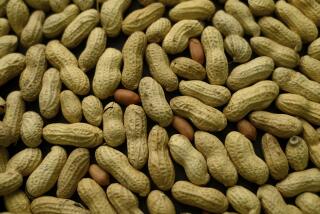They’d Better Watch Out
- Share via
It might seem odd that Stephanie Lewson brought her own pumpkin pie to Marie Callender’s, a restaurant known for its pies. Weirder still that she cut the dessert into 1-inch squares, speared them onto toothpicks and passed them out to the 15 women gathered at the Lake Forest restaurant.
As Lewis rattled off the ingredients (Mocha Mix, flavorless gelatin, Tofutti cream cheese, egg replacer), they oohed and aahed over the flavor and texture. Finally, a pumpkin pie that wouldn’t, literally, kill their children. They had to have the recipe.
The women, all mothers of children with potentially fatal food allergies, meet once a month to share recipes, Web sites and advice on getting their kids through the day alive, a tactical feat that gets more complicated at this time of year.
“While the words ‘holiday party’ strike joy in most hearts, they strike terror in ours,” said Leslie Lawicki, a Mission Viejo mom who was running the meeting and whose 3-year-old son is seriously allergic to eggs, milk and nuts.
“Even if a hostess says the food will be safe, almost no one realizes all the hidden ingredients in foods.”
Nor do they usually grasp the severity of some allergies. Lawicki described discovering that the Thanksgiving corn had been cooked in butter, and a well-meaning relative saying, “Oh, just rinse it off in the sink.”
“They just don’t get it,” she said.
Severe food allergies affect 5% of all children, according to Anne Munoz-Furlong, executive director of the Food Allergy Network, a nonprofit organization based in Fairfax, Va. And six foods--milk, eggs, peanuts, nuts grown on trees, soy and wheat--cause 90% of those allergies.
Experts don’t know why more children are developing severe food allergies, which are a type of immune disorder, but some suspect the increase could simply be the result of better reporting of allergy problems or an increasing incidence of both parents who have allergy genes passing them on to their children. Other culprits may be early exposure to certain proteins as well as environmental factors.
For many of these kids, their reactions are so severe that mere contact with the food triggers anaphylactic shock, a massive release of histamines in the system that can bring on swelling, hives, breathing difficulty, heart irregularity and unconsciousness, and can lead to death.
Fortunately, Munoz-Furlong said, most children outgrow most allergies, although nut allergies tend to be lifelong. But getting these kids to puberty takes hyper-vigilant parenting.
“People don’t realize this is not just an intolerance to the food but a fatal allergy,” said Lauralyn Markle of Laguna Niguel, whose 6-year-old daughter once had a serious reaction when she kissed her dad on the cheek after he had eaten cereal with milk. “Just sitting at a table where someone had just eaten a peanut butter sandwich could be deadly.”
And it’s tough to have to constantly remind people about the problems without annoying them, said Lewson of Huntington Beach, whose 3-year-old Michael is seriously allergic to dairy, eggs and nuts, and who started preschool this year.
*
Avoidance is the only protection--but try explaining that to Sara or Johnny when they want to attend the school holiday party or have cocoa and cookies after caroling. And Christmas at Grandma’s? Forget it.
“Every time someone else cooks, in spite of the good intentions, you can count on a sick kid and a trip to the hospital,” said Rhonda Hansen of Rancho Santa Margarita, whose 10-year-old son is allergic to milk and eggs. As a result, she, like the other mothers in the group, tries to hold family holiday gatherings at home or, if they go to a relative’s, she brings the child’s food. They all also carry such medications as Benedryl and epi-pens, prepared syringes that help ease or block an allergic reaction.
“We’ve had to leave many parties, even from relatives’ homes, who say they get it, then put out bowls of peanuts,” said Gay Rams of Laguna Hills, whose 8-year-old daughter is allergic to nuts and eggs. Rams learned of Ariella’s condition when the girl was 11 months old and she nearly died from just touching peanut butter on a cracker. Recently the Ramses went to a cousin’s bar mitzvah, and although the hosts were aware of Ariella’s condition, there were Reese’s peanut butter cups on every table.
“If just one relative would have eaten one, then given Ariella a kiss, it could have been the kiss of death,” Rams said.
“Your life becomes about packing up safe food,” said Markle, a physician who almost never leaves the house without a meal for Kelly, who’s allergic to milk, eggs and peanuts. “We never let Kelly eat anything prepared by someone else. Even if a relative has used an allergen-free recipe, it only takes one cross-contamination with a utensil or dish to cause a severe reaction.”
The general public doesn’t know all the hidden threats. Milk, for example, can be identified as whey, casein and 33 other names; the mothers of children allergic to dairy products know the list by heart. Eggs have 15 pseudonyms.
“Milk substitute, soy margarine and egg replacer are not staples in most pantries,” Lawicki said. “You can never go to someone’s house for dinner and just relax.”
They can relax, however, during the two parties that the support group holds each year. One party is held around Halloween, a particularly tough holiday on the kids, and the other in spring. The mothers plan the menu together to make sure all the children can eat everything.
Similarly to groups across the country, these women are trying to spread awareness of allergies, something that members concede is an uphill battle. For example, Markle says, she dreads back-to-school night, when she tells the other parents about Kelly’s allergies. A lot rides on teacher and parental cooperation because four out of six fatal food reactions in U.S. children occur at school.
And while Markle--or the other moms--don’t expect perfection, they hope that by explaining the situation and its seriousness, they can make a few time-pressed moms and dads think twice about slapping together a peanut butter and jelly sandwich for their children’s lunches.
“Most parents are great,” Markle said, “but later you hear that someone complained because she couldn’t make the class peanut-butter cookies because of one kid.”
Hansen tries to head off such complaints by always volunteering to bring the food for class parties.
“I make milk- and egg-free cookies and cakes, and the kids don’t even notice the difference.” But she says she rarely mentions the ingredients to other parents because “if I tell people, they turn up their nose.”
Staying slightly ahead of each curve is a necessity for these moms, who want to give their children as normal a holiday experience as possible.
Lawicki calls ahead of every party to find out the menu. If there will be a cake, she asks what flavor and what color frosting, then she whips up an equivalent. When her son was invited to a cookie-decorating party recently, Lawicki made him his own gingerbread men and frosting. And when they visit Santa, she brings a safe lollipop and sneaks it to Santa when Jake’s not looking.
*
Like most kids with food allergies, Kelly Markle was unaware of being really different until a couple of years ago, when she was 4 or 5: “I remember being out with my Mom and somebody walked by eating pizza and I felt that I couldn’t do all the stuff other people can.” At that point she realized that having food allergies meant having limits. Today, when asked what she’d like to eat most, she says, “Everything in the whole wide world.”
As children get older and don’t want their moms at their elbows, parents have to get even more creative. When Gabriel, Hansen’s 10-year-old, goes Christmas caroling with his church group this season, Hansen will be ready when the group returns to the church for hot chocolate. She’ll slip into the kitchen with her own pan, spoon and soy milk, and make Gabriel his special cocoa.
“I don’t know what I’ll do when he doesn’t want me in the kitchen at every party,” she said.
For issues such as that one, the group helps tremendously, said Markle, who appreciates the support and understanding from other moms who have experienced the same things that she has to go through. Times like now, when she’s trying to book flight plans for her family’s winter ski vacation and the airline is reluctant to substitute pretzels for the peanuts on the flight.
“They don’t understand the reaction to those airborne particles that could happen when hundreds of people open peanut bags. And I don’t want to find out at 30,000 feet up.”
Six Foods Lead to 90% of Food Allergies
Soy
Tree nuts
Wheat
Peanuts
Milk
Eggs
Source: Food Allergy Network
More to Read
Eat your way across L.A.
Get our weekly Tasting Notes newsletter for reviews, news and more.
You may occasionally receive promotional content from the Los Angeles Times.










